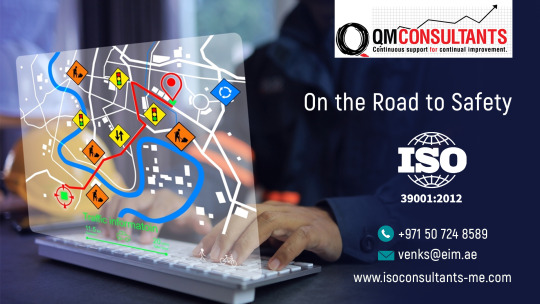Text
ERP Consultancy

A lot of companies go for ERP blindfold resulting into huge cost and time overrun. The SMEs have challenges in understanding the capabilities and boundaries of ERP system they are buying. Mostly they look at ERP as solution for everything. Once the project gets started, they come to realize that they are buying a monster that needs to be tamed. 70% of ERP implementations fail to succeed and that is a conservative figure! As ERP experts, we provide the right leadership to the project and become the main hub for the ERP project. Right from pre-sale to post sale successful handing over we manage the project for you through strict timelines. You do not need to appoint an in-house expert to work with outside developed or vendor. We would talk their talk and ensure full customisation of the ERP to suit the needs and requirements of your organization.
#iso consultancy services#iso 14001#iso 27001#iso 45001#iso 9001#iso 9001 certification#iso accreditation#iso approved#iso certification#iso certification consultancy
0 notes
Text
ISO22000:2017
Food Safety Management

Benefits
1) Safer food
2) Less food wastage
3) Safer Kids
4) More profitable food business
5) Sustainable
Key Requirements
a) Food safety Policy
b) Determination and application of SOPs
c) Determination and application of all PRPs
d) Risk Assessment
e) O-PRPs for all high risks
f) Apply GMPs for food based manufacturing units
#iso consultancy services#iso 14001#iso 45001#iso approved#iso 9001 certification#iso certification#iso 9001#iso 27001#iso accreditation#iso certification consultancy#Food Safety Management
0 notes
Text
AI Powered Marketing

Welcome to QM Consultants, your strategic partner in driving digital success! We are experts in harnessing the extensive powers of AI to deliver you a range of marketing, product, sales, and email Campaign related services. Our services would make every campaign of yours cost and time efficient. As a business owner or senior manager, you understand the importance of a robust online presence and effective digital strategies. Our suite of services is tailored to catapult your brand to new heights, encompassing digital brand building, product development, and campaign management.
https://isoconsultants-me.com/
#QM Consultants#Iso Certification In UAE#ISO Consultancy Services#ISO Certification Consultancy#iso certification#iso certified certificate#iso 9001#iso certified companies#iso accreditation#iso 27001#iso 45001#iso approved#iso quality certification#iso quality management system#iso 9001 certification#iso 14001
0 notes
Text
The Role of AI in Prompt Engineering for Digital Marketing: Crafting the Perfect Query

Businesses all over the world are increasingly using AI-based tools. One of the key elements that harnesses the power of AI Is the “PROMPT”. A prompt is the query that you send to the AI tool to get your work done. Understanding what prompts are, how they become effective tools in AI, and the components of a good prompt is crucial for marketers seeking to maximize the potential of AI-driven strategies.
What is a Prompt?
A prompt in the realm of AI refers to a command or input given to a machine learning model to perform a specific task. It serves as a query that guides the AI system in generating responses or outputs. In digital marketing, prompts play a pivotal role in extracting relevant information, understanding user intent, and delivering personalized content to target audiences.
The Effectiveness of Prompts in AI:
Prompts are not just strings of text; they are the conduits through which AI algorithms interpret and respond to user queries. The effectiveness of a prompt lies in its ability to elicit the desired information while considering the context of the user's intent. As AI becomes increasingly sophisticated, prompt engineering becomes an art form, shaping the quality and relevance of AI-generated outputs.
User Interaction:
Prompts serve as the primary means of interaction between users and AI tools.
Users input queries or commands in the form of prompts to initiate AI-driven processes.
Task Definition:
A well-crafted prompt helps define the task or objective for the AI tool.
It specifies the nature of the information or action the user expects from the AI system.
Intent Recognition:
Prompts assist AI in recognizing user intent by providing clear instructions or inquiries.
Understanding the user's intent is crucial for generating relevant and accurate responses.
Data Input:
Prompts act as a mechanism for inputting data into AI systems.
They guide the AI model on the type of information it should process or analyze.
Personalization:
Prompts contribute to personalization by allowing users to tailor their queries based on individual preferences.
AI tools leverage this personalization to deliver more customized and relevant outputs.
Context Establishment:
Prompts help establish context by considering the user's previous interactions and the ongoing conversation.
Context-aware prompts enable more coherent and contextually relevant AI responses.
Quality Control:
Crafting precise prompts is a form of quality control in AI.
Well-structured prompts contribute to the accuracy and reliability of the AI tool's outputs.
Adaptability:
Prompts can be adapted to different scenarios and user contexts.
An adaptable prompt ensures that the AI tool remains effective across a range of user queries and situations.
Feedback Loop:
User feedback, often provided through prompts, can be used to refine and improve AI models.
Analyzing the effectiveness of prompts based on user responses helps in continuous optimization.
Keyword Identification:
Prompts include keywords that guide the AI model in identifying relevant information.
These keywords are crucial for the AI tool to comprehend and respond to user queries accurately.
User Engagement:
Engaging prompts encourage users to interact more with AI tools.
A well-designed prompt can make the user experience more enjoyable and effective.
Task Automation:
Prompts are instrumental in automating tasks by providing clear instructions for AI systems to follow.
This facilitates streamlined processes and efficiency in performing routine or complex tasks.
Query Refinement:
Users can refine their queries through prompts, allowing them to iterate on their requests.
Iterative refinement contributes to the precision and relevance of AI-generated responses.
Decision Support:
Prompts aid in decision support by framing queries that prompt AI systems to provide insights or recommendations.
They enable users to leverage AI for data-driven decision-making.
In summary, prompts play a multifaceted role in guiding, instructing, and enhancing the effectiveness of AI tools across various applications. Crafting clear, context-aware prompts is essential for leveraging the full potential of artificial intelligence in user interactions and data processing.
Features or components of a Good Prompt:
Clarity and Specificity:
A good prompt should be clear and specific, leaving no room for ambiguity. Vague or generalized prompts can lead to inaccurate responses and hinder the effectiveness of the AI system.
Relevance to User Intent:
Understanding user intent is crucial in prompt engineering. The prompt should align with the user's expectations, ensuring that the AI system comprehensively addresses the user's query.
Context Awareness:
Effective prompts consider the context. They take into account previous interactions, user behavior, and the broader context of the conversation. Context-aware prompts enhance the AI system's ability to generate more relevant and personalized responses.
Inclusivity of Keywords:
Including relevant keywords is essential for prompt success. These keywords act as cues for the AI model, helping it grasp the user's requirements and generate accurate outputs.
Adaptability:
A good prompt should be adaptable to various scenarios. As user queries evolve, the prompt should remain effective in generating responses across different contexts.
Prompt Engineering: Crafting the Perfect Query
Prompt engineering is the process of fine-tuning prompts to optimize their effectiveness in AI applications. It involves the iterative refinement of queries to enhance the performance of machine learning models. Marketers engaged in prompt engineering seek to understand user behavior, analyze data patterns, and create prompts that resonate with their target audience.
In the landscape of AI, prompt engineering can be likened to crafting the perfect query that unlocks the full potential of AI technologies. By investing time and resources in honing the art of prompt engineering, marketers can elevate their AI-driven strategies, delivering more personalized and engaging content to their audiences.
Conclusion:
As AI continues to shape the future of businesses, prompt engineering emerges as a critical skill for marketers seeking to stay ahead in the competitive landscape. Understanding the components of a good prompt and the nuances of crafting the perfect query empowers marketers to harness the true potential of AI in delivering targeted, relevant, and personalized content to their audiences. Embracing prompt engineering is not just a technological necessity; it's a strategic move toward a more effective and impactful digital marketing future.
#iso consultancy services#iso 9001 certification#iso accreditation#iso approved#iso 9001#iso 45001#iso 14001#iso 27001#iso certification#iso certification consultancy#digital marketing future#prompt engineering#quality control in AI#digital marketing#social media marketing#search engine optimization#online marketing#seo#seo services
0 notes
Text
Food Safety Managements

If you are in a food-related business and feel that your current system has gaps then you should call us. We have food safety consultants who have not only in-depth experience in handling food management systems like ISO22000, FSSC, and BRC, etc to suggest you everything from the right SOPs to the right manpower and also enable you to buy from the right sources.
https://isoconsultants-me.com
#QM Consultants#Iso Certification In UAE#ISO Consultancy Services#ISO Certification Consultancy#iso certification#iso certified certificate#iso 9001#iso certified companies#iso accreditation#iso 27001#iso 45001#iso approved#iso quality certification#iso quality management system#iso 9001 certification#iso 14001
0 notes
Text
AI Powered Marketing

Welcome to QM Consultants, your strategic partner in driving digital success! We are experts in harnessing the extensive powers of AI to deliver you a range of marketing, product, sales, and email Campaign related services. Our services would make every campaign of yours cost and time efficient. As a business owner or senior manager, you understand the importance of a robust online presence and effective digital strategies. Our suite of services is tailored to catapult your brand to new heights, encompassing digital brand building, product development, and campaign management.
#QM Consultants#Iso Certification In UAE#ISO Consultancy Services#ISO Certification Consultancy#iso certification#iso certified certificate#iso 9001#iso certified companies#iso accreditation#iso 27001#iso 45001#iso approved#iso quality certification#iso quality management system#iso 9001 certification#iso 14001
0 notes
Text
Food Safety Management

Benefits
1) Safer food
2) Less food wastage
3) Safer Kids
4) More profitable food business
5) Sustainable
Key Requirements
a) Food safety Policy
b) Determination and application of SOPs
c) Determination and application of all PRPs
d) Risk Assessment
e) O-PRPs for all high risks
f) Apply GMPs for food based manufacturing units
#ISO Consultancy Services#Road Traffic Safety Management System#ISO 39001:2012#On the Road to Safety#RTSMS Policy#RTSMS#road safety is a journey#Quality Management Systems#ISO9001#road safety#ISO9001 compliance
0 notes
Text
On the Road to Safety: A Deep Dive into Journey Planning According to ISO39001:2012

Road safety is a shared responsibility that extends beyond the driver's seat. As organizations strive to meet more strict road safety regulations, and international standards such as ISO39001 (Road Traffic Safety Management Systems) and ISO9001 (Quality Management Systems), the significance of thorough journey planning becomes paramount. In this blog, we will delve into the intricacies of journey planning, exploring when and how to create a plan, the essential components of the process, and methods to measure its effectiveness.
The journey plan as per ISO39001:2012 is part of the Operations planning. It optimizes resources like vehicles, drivers, roads, and the environment in order to get an outcome of safe journeys, and on-time arrivals, and achieve drivers’ and passengers’ satisfaction.
Section 1: When to Make a Journey Plan
The Pre-emptive Approach:
Every moment the road situation changes and lack of journey planning means hurrying and driving rashly to reach Place B from Place A so as to avoid delays and unpleasant situations. One may follow a planning approach and truly embody the spirit of ISO39001. Journey planning means adopting the PDCA (Plan-Do-Check-Act) strategy of ISO9001 should be ingrained in the organizational culture. Every trip, whether short or long, routine or exceptional, warrants a journey plan. Begin by identifying situations that necessitate a plan:
Routine Trips: Daily commutes and recurring routes should not be exempt from planning. Familiarity can breed complacency, making routine trips susceptible to oversight. A short trip of 10 minutes may take 1 hour due to road accidents, lack of fuel in the vehicle, or sudden traffic buildup. It is always advisable to track the conditions of the roads 30 minutes before the start of the journey.
Special Events or Projects: Any deviation from the ordinary, such as events or projects, demands meticulous planning to accommodate potential changes in traffic patterns, road closures, parking situations, or increased congestion.
Weather or Seasonal Changes: Adverse weather conditions can significantly impact road safety. Journey planning becomes crucial during seasons prone to hazards such as water puddles due to rain, or fog.
Long-Distance Travel: Trips beyond the usual territory require comprehensive planning. Factors like rest breaks, Fuel station locations, vehicle conditions, Vehicle repair shops on the way, alternative routes, and overnight stays should be considered.
Section 2: How to Make a Journey Plan: Best Practices from Road Traffic Management System
Step-by-Step Guide:
Creating a journey plan involves a systematic approach. Follow these steps to ensure a robust plan:
Identify the Purpose and Scope: Clearly define the purpose of the trip and its scope. Consider whether the journey involves transporting goods, employees, or clients.
Route Planning: Leverage technology and mapping tools to identify the optimal route. Account for potential traffic disruptions, construction zones, and alternative routes.
Vehicle Inspection: Ensure the vehicle is roadworthy by conducting pre-trip inspections. Check tires, brakes, lights, and fluid levels to minimize the risk of breakdowns.
Driver Training and Awareness: Equip drivers with the necessary skills and knowledge for defensive driving. Emphasize adherence to traffic laws and encourage defensive driving techniques. This can be done through a toolbox talk.
Communication Plan: Establish a communication protocol to keep all stakeholders informed. This includes notifying relevant parties of the departure and arrival times, any delays, or emergencies.
Emergency Preparedness: Include contingency plans for unforeseen circumstances. Provide drivers with emergency contact information, and equip vehicles with necessary safety equipment.
Section 3: Important Components of the Journey Planning Process: Go the Road Traffic Safety Management way
Elements for Success:
An effective journey plan comprises several crucial components:
Risk Assessment: Evaluate potential risks associated with the trip, considering factors such as weather, traffic conditions, and the nature of the journey.
Driver Competency: Ensure drivers possess the necessary skills and qualifications for the specific trip. Regular training programs contribute to ongoing driver competency.
Vehicle Maintenance: Implement a rigorous maintenance schedule to keep vehicles in optimal condition. Regular inspections prevent breakdowns and enhance overall safety.
Legal Compliance: Adhere to local and international traffic laws. Compliance with ISO39001:2012 standards ensures a commitment to legal requirements and continuous improvement in road safety.
Communication Protocols: Establish clear lines of communication between drivers, dispatchers, and relevant stakeholders. Real-time updates contribute to efficient journey management.
Section 4: Measuring Effectiveness and KPIs for Success
Metrics for Success:
Measuring the effectiveness of a journey plan is essential for continual improvement. Key Performance Indicators (KPIs) include:
The trip planning measurements would include;
Frequency of Trip Planning
Components of trip plan that are taken into consideration
Trip planning tools available for the organization
Monitoring & approval of trip plans where the risks are rated “High”
Incident Rate: Track the frequency of incidents and accidents during trips. A declining incident rate indicates the plan's effectiveness in mitigating risks.
The results of Trip planning can be evaluated through:
Compliance with Regulations: Monitor adherence to ISO 39001 and local traffic regulations. Non-compliance can indicate areas for improvement in the journey planning process.
On-Time Performance: Evaluate the punctuality of trips against the planned schedule. Consistent on-time performance reflects the efficiency of the journey plan.
Driver Feedback and Evaluation: Solicit feedback from drivers regarding the journey plan. Regular evaluations help identify challenges and areas for improvement.
Cost Efficiency: Assess the overall cost of journey planning, including fuel, maintenance, and other associated expenses. Identify opportunities for cost reduction without compromising safety.
Incidences – No. of incidents that are related to vehicles (breakdown/ tire bursts/), driver fatigue, Speeding fines, delays, etc., should be also used as metrics.
Conclusion:
In conclusion, effective journey planning is not only a cornerstone of road safety but also an integral aspect of ISO39001 and ISO9001 compliance. By understanding when to make a journey plan, how to create one, and the essential components involved, organizations can safeguard their personnel, assets, and reputation.
Remember, road safety is a journey, not a destination. By continuously evaluating and refining journey plans, organizations can navigate the roads with confidence, ensuring the well-being of their drivers and contributing to a safer transportation ecosystem.
Ideally, organizations should invest in trip-planning apps and every user of the organization should be mandated to use the app. There should be an approval hierarchy for trips that are more than 50km from the company/ home location.
#Road Traffic Safety Management System#ISO 39001:2012#On the Road to Safety#RTSMS Policy#RTSMS#road safety is a journey#Quality Management Systems#ISO9001#road safety#ISO9001 compliance
0 notes
Text
ISO Standards' Consultancy

QM Consultants have got expert consultants who have in-depth knowledge in various ISO standards and have the skill set to advise, guide and support so that you get the coveted accreditation. The consultants from QM Consultants are chosen from relevant fields and MUST have at least 15 years of experience in and this ensures width and depth of consultancy. We provide you easy translation of the requirements for any of the standards listed below. We not only consult but also hold your hands during the entire implementation stage. We care for your budget and hence provide solutions that are affordable and yet comprehensive.
#QM Consultants#Iso Certification In UAE#ISO Consultancy Services#ISO Certification Consultancy#iso certification#iso certified certificate#iso 9001#iso certified companies#iso accreditation#iso 27001#iso 45001#iso approved#iso quality certification#iso quality management system#iso 9001 certification#iso 14001
1 note
·
View note